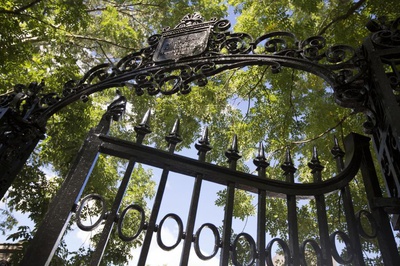
News
Nearly 200 Harvard Affiliates Rally on Widener Steps To Protest Arrest of Columbia Student

News
CPS Will Increase Staffing At Schools Receiving Kennedy-Longfellow Students

News
‘Feels Like Christmas’: Freshmen Revel in Annual Housing Day Festivities

News
Susan Wolf Delivers 2025 Mala Soloman Kamm Lecture in Ethics

News
Harvard Law School Students Pass Referendum Urging University To Divest From Israel
SEAS Researchers Invent Technology to Improve Lenses

Researchers at the School of Engineering and Applied Sciences have developed a microscopic material called a “metacorrector” that fixes chromatic aberrations in lenses — a revolutionary alternative to the bulky, expensive glass lenses used today, according to a study published in Nano Letters on Nov. 13.
Applied Physics Professor Federico Capasso, postdoctoral fellow Wei-Ting Chen, and graduate student Alexander Y. Zhu pioneered this technology, alongside other members of the Capasso Group and researchers at other institutions.
A single-material lens will focus different wavelengths of light to slightly different points, according to Chen. The discrepancy between the wavelengths’ focal points creates a blurry effect, known as a chromatic aberration. Since the 17th century, traditional lenses have remedied this problem by combining multiple glass materials. The image is no longer blurry, but the lenses themselves are heavier and more costly to manufacture.
“Without putting two glasses together, there is no way to compensate for chromatic aberrations, according to conventional wisdom,” Chen said.
The metacorrector presents an alternative to chunky lenses.
Chen and his collaborators defied centuries of convention by developing a “single layer nanostructure” that varies lens curvature in response to the specific wavelength of light hitting the lens. For example, the metacorrector functions as a convex lens for red light — meaning the lens is curved outward — and as a concave lens for blue light — meaning the lens is curved inward.
“If you have a lens, its curvature determines the function,” Chen said. “Here, it actually varies its function from concave lens to convex lens, depending on the incident wavelengths. That’s the key to overcoming chromatic aberrations in our design.”
Chen said the metacorrector has the potential to make any optical system more compact, from microscopes, to augmented and virtual reality devices, to cameras.
Visual Arts Professor Alfred Guzzetti ’64 said the idea of manipulating lens curvature on a nanoscale level is “pretty amazing.” He said he was especially fascinated by how the action of light hitting the lens could instruct the lens to behave in a particular way.
In particular, Guzzetti said the cost-effectiveness of the metacorrector would avoid the steep manufacturing costs of high-end lenses, which can cost upwards of $12,00, and make the technology more accessible to everyday consumers.
Visual and Environmental Studies Department Chair Robb Moss wrote in an email that the metacorrector — like other technological developments in film, such as zoom lenses and the ability to shoot in low light — will create opportunities for filmmakers to experiment and innovate.
“I am excited to see how these new lenses will see the world,” Moss wrote.
Harvard has protected the intellectual property concerning the metacorrector and is looking into the possibility of commercializing its technology, according to a SEAS press release published Nov. 19.
Correction: Dec. 3, 2018
A previous version of this article incorrectly indicated that Visual Arts Professor Alfred Guzzetti ’64 said high-end lenses can cost upwards of $1,200. In fact, the said he lenses can cost upwards of $12,000.
—Staff writer Amy L. Jia can be reached at amy.jia@thecrimson.com. Follow her on Twitter @AmyLJia.
—Staff writer Sanjana L. Narayanan can be reached at sanjana.narayanan@thecrimson.com.
Want to keep up with breaking news? Subscribe to our email newsletter.
Most Read
- Harvard Dismisses Leaders of Center for Middle Eastern Studies
- 2 Years After Affirmative Action Ruling, Harvard Admits Class of 2029 Without Releasing Data
- Russian HMS Researcher Detained at Louisiana ICE Facility After Visa Revocation
- Harvard Agrees to a 1-Year $6 Million PILOT Agreement With the City of Cambridge
- More Than 600 Harvard Faculty Urge Governing Boards To Resist Demands From Trump
From Our Advertisers

Over 300+ courses at prestigious colleges and universities in the US and UK are at your disposal.

With innovative financial tools combined with financial education, Collegiate empowers students to take control of their finances and build confidence in their money management skills.

Serve as a proctor for Harvard Summer School (HSS) students, either in the Secondary School Program (SSP), General Program (GP), or Pre-College Program.

With an increasingly competitive Law School admissions process, it's important to understand what makes an applicant stand out.

Welcome to your one-stop gifting destination for men and women—it's like your neighborhood holiday shop, but way cooler.

Admit Expert is a premium MBA admissions consulting company, helping candidates secure admission to top B-schools across the globe with significant scholarships.
